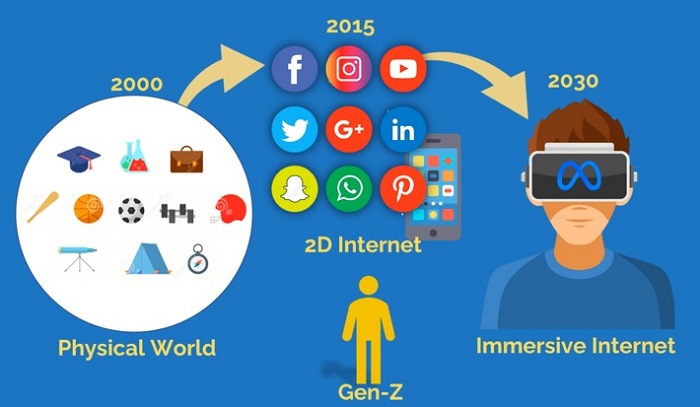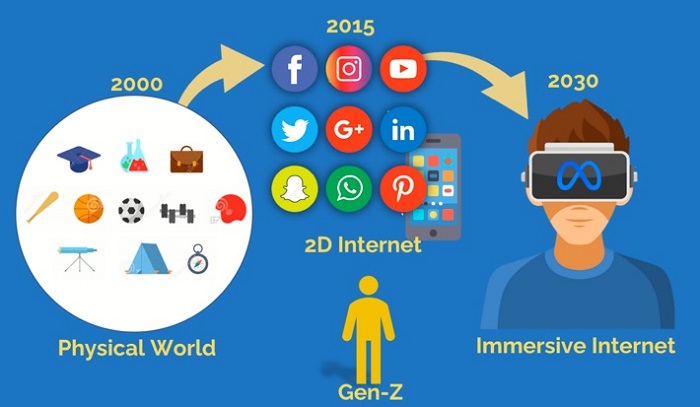- Global digital landscape will be dominated by 5G enabled online experiences
- Next zillionaire will be those who harness the rich database in the virtual world/ Meta

 Imagine the immersive experience of watching your favourite EPL team playing in Old Trafford from the eyes of one of the players on the field; or in a driver’s seat in the Formula 1 race in Monaco – while physically located 11,000km away in Kuala Lumpur. Imagine competing in a cycling race anywhere across geographical borders, without physically travelling the route. Imagine attending a lecture hall in New York University, minus the heavy cost of living.
Imagine the immersive experience of watching your favourite EPL team playing in Old Trafford from the eyes of one of the players on the field; or in a driver’s seat in the Formula 1 race in Monaco – while physically located 11,000km away in Kuala Lumpur. Imagine competing in a cycling race anywhere across geographical borders, without physically travelling the route. Imagine attending a lecture hall in New York University, minus the heavy cost of living.
That is what Metaverse or short-form Meta virtual world promises!
In the remaining half of this decade, the virtual world will redefine the way we watch and/or do sports, educate, experience entertainment, watch movies, attend live concerts, interact with loved ones, etc. The global digital landscape will be dominated by 5G enabled online experiences and its use case at its peak – driven by the Meta.
Now, imagine the impact to the adjacent economic sectors such as services, tourism & hospitality, and financial institutions. It will be the key catalyst in re-writing the next chapter of digital economy and pivot the construct of a country’s GDP indirectly.
Every 10 to 15 years, the screen technology disrupts and evolves – in the 90s it was desktop, in the 2000’s it was laptop, in 2015 it was mobile phones and 2030 it will be the virtual world!
Next phase of the Internet – past decade
The meta promises a set of immersive, interconnected, and interoperable digital space that represents the evolution of the internet as it exists today. Simply put, instead of you watching the internet, this time you will be inside the internet and social media with more than ever dopamine and adrenaline drive, fear of missing out and sense of stickiness. Sounds exciting?
In the past decades, according to data from Hootsuite, Digital Trends 2021 that was released this month, social media subscribers jumped from 1.5 billion in 2011 to 4.5 billion in 2021 with a compounding growth of 12% – this led to exponential increase in global data consumption from mere ~0.5 Exabytes or EB/month to 75EB/month with a 65% compounding growth said a report by OpenSignal, in May 2021, “Malaysia’s mobile data consumption surge in 2020.”
The average digital screen time is around 7 hours a day from the internet. In the Malaysian context, we consume around 9 hours of digital screen time a day with a total data usage of 1EB/month. The increase in data is mostly in the form of videos and adaptation of social media base content – in short, content you and I post and view.
How does it look like by end of the decade, 2030?
This trend of increasing data usage is forecasted to continue in the next ten years, where the growth will be driven by the virtual data and digital properties in the Metaverse realm. From only interacting with two senses today – sight and sound, it is predicted that advanced technology will allow us to experience full internet of senses by 2025 and to have completely immersive digital communication by 2030.
By 2025, AR wearables will instantly translate languages, allow us to control our sound environment and experience smell, taste, textures, and temperature digitally. As consumers step further into this sensory digital world, they will require hyper-fast connectivity, edge computing and advanced automation.
What about 2035?
Bring it forward to 2035, there will be ~9 billion population globally along with ~4-5 billion virtual people – sadly, not everyone in virtual world will be alive at that moment, but they will have full digital footprint, personas, and twin statuses as if they were alive. Your great grandchildren could be able to have a discussion with you 150 years from today about your lockdowns during Covid pandemic. Its “you” and yet “not you” having that little chat!
The next zillionaire (> US$1,000 trillion) will be those who harness the rich database in the virtual world/ Meta. This means unlike the physical world, every activity one would do in the virtual world will create a digital footprint and be able to make one’s digital persona more accurate. Most data from real world, Amazon, FB, Google and Tik Tok may pivot to virtual which will create a massive database to be harnessed. And the privacy of individual proprietary data will be widely discussed and a governed topic in this era. Zhang Yiming, the founder of TikTok is predicted to reach the trillion marks in 2030 as being the youngest trillionaire. Elon Musk is set to join this league in 2024, 6 years ahead of Yiming.

How could the telecom industry deliver Virtual World/ Meta?
Meta is all about “low latency internet”, not just the high-speed internet. A network which delivers lowest time gap for signals, “latency”, i.e., time it takes from our device to reach the internet cloud and return – being less than 10 milliseconds.
For comparison’s sake, when someone nearby speaks, it takes 40 milliseconds to reach us and for us to have a perfect conversation. Meta needs to cut this down by 3x or 75%.
Most Asian telecom networks delivers a latency in the range of 20 to 150 milliseconds, and it has regional and time specific variations, hence there could be a gap.
In today’s applications, video calling and cloud games require a round-trip time latency of 75 – 150 milliseconds, and this could even go down to sub 30 milliseconds in the case of multi-player or complex games. But in the future, a head-mounted mixed reality display – where graphics must be rendered on screen in response to where someone is focusing their eyes will require single digit milliseconds.
The exhibit below illustrates the evolution of the telecom network from a static, hardware defined layer to a dynamic, software defined layer within the next 10 years.
Telecom networks shifting focus from cost per GB to cost per Millisecond
This is all about creating storage and computing, closer to the user. Meaning, processing, and storage to have a short routing circuit vs a long route. To reach to 10 milliseconds, firstly, a network may need massive amounts of edge points perhaps to the tune of 1 edge box for every 10 collections of sites, and secondly, network densification and deployment of large amount of radio units needs to be implemented.
At the advanced phase, a dense city needs to deploy 100 to 200 small cells per every km2 vs 2- 3 km in a traditional 2G/4G era. These will be in the form of streetlight, balcony mounted, rooftops, bus stops, clock towers, minarets, church bells, etc which will blend in with the city’s aesthetics and beautification thereof. Perhaps, evolution into ‘Community based’ layer where your car, bus, backpack and wearables will be part of the radio units in the future which have a trade-off between data you consume from the data grid and data you would contribute to the data grid.
And as the industry progresses, it will be economically challenging to keep building additional low latency data capacity in a hardware defined aggregated network – this may potentially transition into a software defined, disaggregated network.
The role of a tower company in the Metaverse journey
Tower companies as neutral party host can indeed help share the infrastructure cost of this massive computing and storage by way of street level sites and edge computing etc. It will be economical for the industry to lease this infrastructure on a shared basis instead of building individual layers which lead to inefficiencies stemming from duplications and overlaps.
And, the industry needs to move from focusing on a “Cost Per GB” to a “Cost Per Latency” model. When you dissect the cost structure and cost elements in the latency world, it is more skewed towards the passive infrastructure [exhibit below]

Conclusion
The telecom industry is evolving to embrace the virtual world/ Metaverse and will be the key catalyst in next decade – this will pivot the telecom industry focus on delivering an ultra-high speed and low latency network and shift from cost per Gb to cost per millisecond targets!
This opportunity calls for a fundamental shift in how networks are architected and deployed as well as an industry-wide collaboration to prepare for the metaverse – With significant advancement required in network latency, symmetrical bandwidth and overall speed, no single company nor industry, can do this alone.
TowerCos are the most strategic partners to enable market collaboration and accelerate the Metaverse adoption via its stronghold within the telco market. This can be achieved through deepened infrastructure sharing and leveraging on analytics-based solution to effectively rollout the next evolution in the digital landscape.
The Future is indeed bright for the telecom infrastructure space!
Gayan Koralage is one of the pioneering members of edotco Group. He speaks and writes frequently as a thought leader in the mobile and neutral party host telecom tower industry, covering key topics of business case for 5G, network disruption, digital economy, digital transformation and inter-generation opportunities in the 2020 decade. Gayan currently serves as the Director, Group Strategy, responsible for long term strategy, pricing, and commercials for the group. And served additional interim roles of acting country managing director of Pakistan and Sr Lanka. He spearheaded the formation and growth of edotco since 2013 to be global top six tower company by count, currently presence in nine Asian markets.

